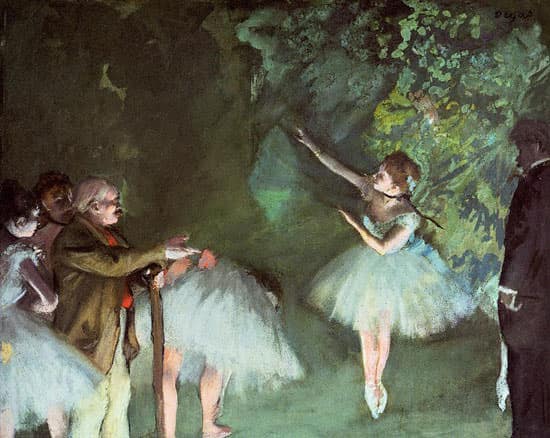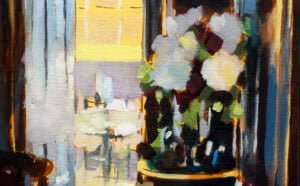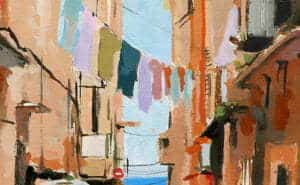
Edgar Degas, Ballet Rehearsal, 1834 – 1917
Green paint is like peanut butter is for dieters, dangerously addictive.
I don’t quite know why, maybe the freshness, the feeling of a landscape, the memory of nature… whatever the reason it’s a bad one.
Step 1. If you buy a starter set of beginners paints, throw away the green that is included (usually this is Emerald green)
It is usually terrible and very unforgiving when trying to create harmonious colour in painting.
“Can’t I use it to tone down red? or use red to tone down the green? I know about complementary colours; I’ve only just bought it, I can’t throw it away!”
You must.
Still got it?…
Why is green such a problem, and how can you solve it?
It is always tempting for a beginner to make the green brighter, add a little more yellow, a little brighter blue. This can be especially dangerous in acrylics because you have nothing for the paint to mix into to help tone it down.
A vivid green can be easy to mix but hard to balance.
You can help yourself tone down the green by:
1. Adding red to the green mix to mute it down.
2. Always try and mix greens from a mixture of two colours rather than premixed greens.
3. Try working on a warm ground, even pinkish, to help balance the tone.
4. Paint in the Autumn!
How to make beautiful greens
Don’t use blue or bright yellow.
Well, not to start with, a good colour to start with is yellow and brown.
Below is a list of mixtures, starting from the dullest through to the most vivid and brightest green:
- Burnt umber & Cadmium yellow light
- Prussian blue & Yellow ochre
- Ivory black & Cadmium yellow light
- Ultramarine blue & Yellow ochre
- Ultramarine blue & Cadmium yellow light
- Phthalo blue (Green) & Cadmium yellow light
- Phthalo blue (Green) & Hansa yellow (sometimes called Lemon yellow)
Don’t be scared of the Burnt Umber & Cadmium Yellow Light; it can be very useful in creating a greenish undertone without going in too strong.
Some nice premixed greens:
If you have to use a premixed green, there are some nice ones; I often favour the more muted tones.
Terre Verte – very handy for toning down pinks in portrait painting. Often used in classical paintings as an undertone colour.
Green umber – appears very muted put can look surprisingly bright when juxtaposed with a warm red based image. (Using the effects of simultaneous contrast to your advantage)
Green gold – as a transparent glazing paint for acrylics this is great. I only usually use a small amount towards the end of a painting to help give areas the ‘wow’ factor. It is quite potent so that you can put your colour mixtures out quite quickly. A small amount is the key. Also nice in watercolours for creating ‘Turneresque’ paintings.
Viridian – Handy for oil painting, gives a deep green.
“This is a very beautiful permanent green, but very dangerous in the hands of the inexperienced painter for grass and trees. How many crimes has it not been responsible for on the canvases of the young landscape painter.”
Harold Speed, commenting on Viridian – taken from ‘Oil painting techniques and materials.’
Green is very easy to overuse, and people often presume you can only produce bright, vibrant paintings with acrylics due to the overuse of bright greens in amateur painting.
The reality is when mixing greens with a more muted acrylic palette; the results can be fantastic and sophisticated.
In the above video, I mix a selection of greens with different blues to show you the huge variety of greens, depending on the blue used.
So do I ever use a vivid green in my landscape paintings?
Yes, but with caution.
Mix your muted greens with other colours on your palette first, and then slowly add tiny amounts of the intense green, and your landscapes will look much more harmonious.
You might also like:
How your hairdresser can teach you to mix colour
The hidden hues of colour mixing
How to choose a basic colour palette for acrylic painting





LOVE THE GREENS – I think I need to buy some new paints though, have been using a beginners box for the last 2 years!
I really am excited about this as greens are a real hit and miss at times, and a lot of paint can be used in the process of reaching those beautiful tones.
THANK YOU
Hi Kim,
Greens can be tricky, especially when you add white into the equation!
Glad you’re enjoying the site and keep experimenting.
Will
Will these green mixtures apply when using oils?
Yes, they will equally work with oil paints
Cheers,
Will
Thanks so much for your videos. I have learned a lot from watching them and refer back to them often. Love the black with yellow for the different green shades. I used the phalo blue with yellow to highlight the lightening
reflection on a tree at night.
Good one Lynn, so pleased you enjoyed the lesson.
Will
Hi will,
I just found this great post on mixing greens. I also enjoyed all the comments and your kind and user friendly responses. You are a great influence to us budding artists. Thank you!
Best wishes, Bridget
Thanks so much Bridget, glad you enjoyed it.
Will
Thanks for a really informative video Will, I found it extremely useful. I’ve been fretting about whether it’s ok to use black as a mixing colour and now you’ve answered that for me!
Hi Sue,
Black can be very useful in mixing colours, so much so that I’m about to put on a post called ‘The 3 myths of black paint’ this week.
Will
Brilliant! I’ll really look forward to that, it will be very timely for me. Thanks for all you share, it is so valuable to beginner artists and there seems to be so little else available online that’s written by professional artists with a proper appreciation of fine art.
You’re welcome Sue. Glad it’s helping your paintings.
Will
Super. Fantastic tutorial. Thanks Will!
Thanks Linda, hope it helped to understand mixing green paint,
Will
Enjoyed your video clip on mixing green…I was especially looking to use a brilliant emerald green color for the painting I am starting.
I like doing landscapes so the info on mixing for natural tree hues was very interesting to me as well. Thanks
Hi Cindy, Glad to hear you enjoyed the mixing green video, the natural tree hues can be really handy when painting landscapes to balance out your paintings,
Will
Dearest Will Kemp
Thank you for the quality and the amount of information coming out of your website. I am a primary school art teacher in Australia and discovered your website during the last school holidays. My ability to teach art (after 5 years in the art room) has just gone through a major revolution. Sorta like a seed in the desert waiting for some rain.
My students are now developing a meta-cognitive approach to art based on the left/right brain theory in drawing and our adventures in colour mixing over the past few weeks has had siblings preempting the lesson based on what older or younger brothers or sisters have told them at home.
We have all learnt quite a bit and my own work is improving. I look forward to doing one of your drawing courses as part of my schedule of professional development.
Kindest regards
John
Hi John,
What a lovely comment to receive! Brilliant to hear that the videos and articles have been helping your students (and yourself) learn about painting and drawing. I’m currently putting together a ‘success stories’ page of students achievements through following the lessons so feel free to email any of your own work ( or your students) to help inspire other budding artists!
Looking forward to seeing you on the drawing course, say hello to the class from me.
Thanks,
Will
After I enter this I’m off to make a color chart of greens similar to your video so that I have a reference on hand! I have been looking for a sankir/proplasmo to use in icon painting and was getting very frustrating. Could not find what I was looking for. Your web site on green mixing gave me the answer. Actually it gave me multiple base tones to try. Which is great because not everyone has the same flesh tones, so neither should the paintings. With these various green tones (not the yellow with phthalo blue) an attempt to do verdaccio style paintings is going to start. Loved the web site. Thanks for the inspiration!!
Hey Jackie,
If you are after a ‘Verdaccio green’ the mix was even more muted than in my video and was traditionally created from a mixture of Mars Black & Yellow Ochre.
Hope this helps your icon painting,
Thanks,
Will
‘The value of teaching children (and grown ups) colour bias’
A five year old student just came up to me in the art room and and said he couldn’t make a good green cos I only gave him warm yellow! I nearly fell over. The colour mixing lesson was weeks ago. The students are currently debating what colours make what colours as they paint….very funny listening.
thanks again for the all information Will.
john
ps: the drawing course is apples too!
Ha, ha, your teaching is working well John! That’s brilliant, really pleased it has helped the students get to grips with colour.
Cheers,
Will
Hi,
Thank you very much, the information is very helpful for me
Hi Will Just found your web site Wonderfully easy to follow colour mixing greens. thanks so much !!!
Hey Sue,
You’re welcome, so pleased the video has helped. Greens can be tricky!
Will
Will,
Thanks so much for sharing your vast knowledge! Not only is it excellent theory, it is of great practical value when actually painting.
You are an excellent artist and teacher.
-Malone
Thanks very much Malone, pleased you’re finding rhe tutorials helpful.
Cheers,
Will
Hi, thanks for the info Will
I haven’t tried mixing my own green yet…..But I wonder what is the green paint for if I shouldn’t use it?
Hi Ron, you can still use it, just with extreme caution! Just try to start with mixing your own muted greens rather than jumping straight for the pre-mixed green, your paintings will look a lot more professional due to this simple change.
Cheers,
Will
Excuse me for being presumptuous Mr Will, but may I suggest some of Camille Pissarro’s landscapes, particularly from Eragny, as very useful examples of muted greens. Here in Ozz ‘Washing day at Eregny’ is a great example. This work is at Queensland’s Art Gallery in Brisbane. I found that one really helpful after viewing your tutorial! Recently, similar Pissarro’s were in the NGV’s Pointillism exhibition.
Regards John
Hi John,
Thanks for the comment, I could only find a small thumbnail image of ‘Washing day at Eregny’
Pissaro is a good painter to look at though, This painting ‘A Corner of the Meadow at Eregny‘ shows a lovely selection of muted green within the composition.
Cheers,
Will
yikes! sorta hoping that thumb nail wouldn’t be found due to its acid green glow. I clicked onto images for ‘wash day’ The Tate example works yes. The mrs, the kids
and I are planning our museum /gallery tour – Rome to London and places in between by train for next northern winter. Look forward to gelato and sketches!
Maybe a bit cold for gelato though.
regards
It sounds like your trip will be a real inspiration.
Never to cold for ice cream John! In fact today we’ve had snow and I’m heading to London to indulge in Gelato at the weekend!
This is my top tip for one of the best icecreams in London also going to try La Gelatiera for the first time, can’t wait.
Cheers,
Will
Thanks Will,
This was a very informative video and very helpful. I liked all of the four types of mixing but my favourite was phthalo blue with yellow, the colours really sang. Best wishes, Ann in South Australia.
Hi Ann,
Thanks for dropping by and really pleased you found the green mixing helpful,
Cheers,
Will
Dear Will,
I’ve been drawing from nature, sketching, and occasionally using water soluble neocolour pastels for colour drawing, but never really dared the step into painting. Yesterday I decided to go for it, and discovered your website. I have to thank you warmly for the most didactic, user-friendly, and complete set of instructions and guidelines that I could ever have dreamed of. The fact that you spent so much time setting up all those detailed free videos commands universal thanks.
I have one question: being in the Netherlands, I use Talens/Amsterdam acrylics, and mixing burnt umber with cad yellow light hasn’t produced the greenish tints that you demonstrate: the range I get stays brownish. They probably don’t use the same pigments as Golden… Do you have any suggestion ? I’ve been struggling with greens for so many years using watersoluble neocolour II, that I’m really very excited at finally getting greens that are closer to what my eyes see in nature :D
Thanks, Michel
Hey Michel,
Thanks for your kind comments and great to hear you’re stepping into painting for the first time.
When mixing Burnt umber with Cadmium yellow the result is a brownish green, however, the yellow pigment strength from Talens isn’t as punchy as the Golden, also they wouldn’t have as high pigment load.
To fix this, you can either increase the yellow opacity by using an artist quality paint, or increasing the blue (this in simple terms will make it greener) in the mix, I would add a tiny touch of Ultramarine blue until you get the tone you’re after.
The other consideration:
Are you viewing the colour in isolation (on a piece of white paper) or in the context of other colours? as this can drastically alter the perception of the colour, it’s called ‘colour constancy’ and changes depending on it’s neighbouring colour.
I hope this helps,
Will
Hi Will,
Thanks for your friendly reply.
I am indeed mixing on white. I’m working on my first composition of our garden, and started from yellow ochre as you recommend, sketching burnt umber and whites first to build the contrast :)
I can’t seem to find the course or video back where you talk about using different palette background colours to compensate for our colour perception biases. Can you point me to the right place please ?
Thanks, Michel
Hi Michel, you’re welcome. It might have been this post where there is a video of the effects of simultaneous contrast of colours.
Cheers,
Will
Hi Will
I’m fairly new to painting (started in my late 40s) and am totally self taught. I love using acrylics and LOVE bright colours and do mainly abstract pictures. I laughed out loud when I read this post! Why? Because I use sooo much green in my paintings!!! I guess to you they will look very amateur but believe it or not I sold my first painting last month (which was the 7th painting I’ve done) and guess which was the predominant colour? Phthalo green LOL!!! How funny is that? The only problem I had working with green was how hard it can be to get it to flow – it’s so thick.
Nevertheless, I have listened to your advice (and I DO value it) and will definitely continue to experiment.
I LOVE your site and I thank you from the bottom of my heart for sharing all your knowledge and expertise.
Many hugs x
Hi Bec,
pleased the article struck a chord! really pleased you’re enjoying the site and bright green!
Cheers,
Will
This video was truly helpful! Thank you!
Good one Patricia.
Cheers,
Will
I think this will be a huge help for me. I do a lot of houses/landscapes for people with quite a bit of grass and trees and have had the hardest time getting the green. I just threw out 5 half-full tubes (gulp) of premixed green paint and I’m starting again with the list you give.
I’m currently working on a large acrylic painting of Big Sur/Bixby Bridge and the angle I’m using has a ton of green & brown and I think this will help. Do any of one of your tutorials help with the detail on grass/plants or rocks? Thanks!
So pleased to hear it Angela, I haven’t got any specific tutorials on painting details of grass and plants, but hoping the new green mixes are helping with your paintings.
Cheers,
Will
Am so thrilled to know about your web site! The tutorial on greens is wonderful! Am just getting back into painting with oil and have forgotten much of the color theory. I have several paintings of garden scenes in mind for my future work and adore greens, therefore, can’t wait to experiment with your combinations of color. My best to you. With appreciation, Sallie Nardone
Hi Sallie,
Thanks for your kind comments and really pleased you’ve been finding the colour mixing tutorials helpful, good luck with your new mixes!
Cheers,
Will
Hi Will, I’ve been reading your articles on color mixing, very helpful, thank you! I have a question though, I don’t use acrylic, I use oil paints. I’ve been watching some tutorials from Dennis Sheehan (he paints landscapes) and his two colors that he uses the most are phthalo green and transparent oxide red. Of course he mixes it with other colors. Yet you say that phthalo green should be thrown away. Are you talking specifically about acrylic phthalo green? I do have very good results with this paint too (in oil). But not straight from the tube of course.
Hi Jana, throwing your Phthalo Green out is a turn of phrase, you can of course create fantastic paintings using Phthalo Green – in the right hands. You just have to be aware of how intense it can be when you’re first starting landscapes as it can very easily throw your mixes out due to the high tinting strength of the pigment. This is the same with acrylic or oils.
Hope this helps,
Will
Hi Will, thank you for the clarification, it makes sense. :)
i really liked the one made with the black ” set “. black was not a colour i bought using one of your begginers guides. so having no black, how do i make those greens ? make a black first….i’m confused ……..
Hi Lu, just mix the Ultramarine blue and Burnt umber and you will have a black you can use.
Cheers,
Will
a quick question for you – do you know what liquitex or winsor&newton black would be closest to golden’s “carbon black”?
thanks so much for this tutorial, i was making truly tragic greens previously!
Hi Chloe, the closest is oils would be Lamp Black from Winsor & Newton made from Carbon black. In Acrylics, there isn’t a direct comparison. Liquitex do a Carbon black in Acrylic ink, but a Mars Black or Ivory black will also give you some great greens.
Cheers,
Will
“Is green ruining your paintings?” — Yes…or at least leaving them lacking. Your colour combination insight is a break through for me. I’ve taken several workshops over the years, and NO ONE gave these valuable tips. I’m new to your sight – but I’m hooked now.
Thank you Will.
Hi Theresa, thanks for dropping by and great to hear your green mixing has been enlightened!
Cheers,
Will
I wish I had watched this video before I completed my last painting, which was my own composition, as I was trying to get a decent dark green but my attempts at adding blue just did not work so I started to add just a touch of black warily (as I thought it was the forbidden colour too).
I thought this video was a must before attempting acrylics.
Thank you
You’re welcome Lynda, hope it helps for your next painting.
Cheers,
Will
Hi Will,
I have some questions about this video.
1) At around minute 1:40, you said: “This is a carbon black”. In the text, you wrote that you used Ivory black. My understanding is that there is not a specific paint called “carbon black”, you used Ivory black, and it belongs to the “carbon black” category. Am I correct?
2) At around minute 1:48, you said: “Black has a blue undertone”. But according to Gamblin,
http://www.gamblincolors.com/artists.grade.oils/blacks/
Ivory Black is warm. Does the color temperature of Ivory Black depend on brands? Can you elaborate?
3) I want to buy a black paint. I only use black to mix green (as you suggested) and use undiluted black to paint darkest dark in a painting. With my usage, among the 4 most common blacks: Ivory Black, Mars Black, Black Spinel, and Payne’s Grey, which one do you recommend? (According to Gamblin, Ivory and Mars are warm, Spinel is neutral, Payne’s is cool.)
Thanks!
Hi Sam,
The Carbon Black is a Heavy Body Acrylic paint from Golden Paints.
In relation to ‘Black has a blue undertone’ I’m referring to the colour bias of black, If you add white to black it is very cool and blue.
Ivory black is a ‘warm black’ when you apply it as a wash.
Different blacks are either ‘warm ‘ or ‘cool’ when you apply them in thin washes depending on the black you are using.
Ivory black is a great black in Oil painting.
Hope this helps,
Cheers,
Will
I have gone green mad in just about every painting of a landscape I’ve done. This is such useful advice.
One I plan to practice with on a regular basis.
Glad to hear it Kim.
Perfect! I’ve been struggling with greens…this is my answer! I’m addicted to your website Will, it’s the first thing I look at in the morning when I sit down at my computer and it’s my last view at night. Thank you!
Pleased you’ve been finding it helpful Kathy.
Will
Hi Will,
I agree about the use of blacks; they seem to make the most natural looking greens of all the mixes you’ve shown. I wonder if making a black between burnt umber and ultramarine first, and then mixing in with a yellow would achieve a similar result to ivory black and yellow
Cheers,
Tony
Sure would Tony.
VERY USEFUL LESSON TO ME.THANK YOU
Hi Will,
Can you please tell me how to mix a bright limey/mossy green colour?
Also, why do some cheap paints have a plastic-ey look and are shiny when dry?
Thanks.
Hi Olivia, did you see a green close to the one you’re after in the video?
Wow fantastic. I could never imagine we could use carbon black to create such green hues.
Just as i get the time i shall register my self for the tutorials.
Thanks a million
Rukhsana
Cheers Rukhsana, hope you enjoy discovering some new green hues.
Will
Thank you Will, I really have trouble getting the greens I need, they always seem unrealistic to me. The greens you blended in the video above are fantastic, I can already see them in a field, trees, bushes. Thank you.
Diane :)
Good one Diane, pleased you’ve found the lesson helpful with your greens!
Cheers,
Will
My local landscape acrylics class has us using Hooker’s Deep Green as the standard green. I’ve mixed it with phthalo blue (green shade) and or ultramarine depending on the landscape.
This Hooker’s deep green seems to be a favourite among botanical artists..
Hi Dom, yes, Hookers green is a great pre-mixed green.
Cheers,
Will
Dear Will Kemp, you are brilliant painter and arts teacher, and your tutorials are just awesome. I have been trying to work with green and to paint this picture: http://www.unheralded.fish/wp-content/uploads/2015/05/tulip.jpg
The results were really disappointing. I have an idea for you on this topic of green: could you create free or paid video tutorial how to paint a picture with dominant green color? As I see on your video tutorials, you have very subtle feeling of colors, and you can create such valuable video lesson.
Hi Tomas, Pleased you’ve been enjoying the mixing green tutorial, your comment is very timely as I am working on a new colour mixing course as we speak that looks at balancing bright and more muted greens in landscapes. Should be out in the new year.
Cheers,
Will
Hi Will Thanks for the great tips on mixing greens. Should you ever mix white with green or just lighten using differing quantities of various yellows
Hi Richard, yes you can mix white with green, it will go towards blue and dull down the green but can be handy for far away trees in the distance.
Cheers,
Will
Such great information Will! Wish I could sign up for everything and then actually wake up everyday and paint. Color has been frustrating me, everything ends up way too bright. I think this video and your other color course will really help.
I would also love to know what song that was
best,
cp
Hi Carol, nice to hear from you, ha, ha, yes learning from osmosis would be fantastic! This would be the perfect lesson to start to see how muted you can go with your colours yet still achieving a sense of the atmosphere of the season.
Cheers,
Will
p.s.Vanessa was music maestro for the video so I’ll check with her.
This has made my day! Has helped rescue a little bunny in grass that I thought was lost. Using cad yellow light + ivory black … Amazing! Thanks again Will.
Loved the blog on green. Is there any way to tone down the green that us beginners have already applied to the canvas? Perhaps a glaze and what color?
Hi Lori, you can tone down a green with a glaze of red.
Cheers,
Will
I wish I had seen this 2-3 weeks ago before I scrapped a painting because the greens didn’t look right! Live and learn!
Which colors do you recommend for teal and jade?
Usually a mixture of Phthalo Blue and Green/yellow and Titanium white.
Cheers,
Will
Sir, your advice helped me in getting bright turquoise after adding hansa yellow. Thank you Sir.
What should be added if I want dark turquoise. Your advice counts. Waiting for your reply
For a darker turquoise just add more blue.
Cheers,
Will
Will,
I am so happy I found your website through Pintrest. I am picking up a paintbrush again after many years.
When deciding whether to go back to oils or try acrylics, every person I spoke to told me acrylics yield bright, often garish results and my only option would be oils.
For a variety of reasons, acrylic painting is the right choice for me right now.
I’m encouraged to see that you use both beautifully and I’m hopeful for my venture into acrylics.
Thanks for sharing your talent!
Really pleased you’ve been enjoying the site Sandra, hope it helps with your painting journey.
Cheers,
Will
I used your post here as a very helpful reference with a large painting I’m doing almost entirely in greens. It was extremely helpful, but I have two questions:
1. What is your advice to create a realistic non-acid light green? I’m struggling with places where the light hits the edges of trees, the lighter greens I’m using look so strong and acidic against the beautiful muted greens.
2. Is it possible to glaze with acrylics? If so, would you mix paint with a gel medium?
Thanks! Will be using your site for reference more in the future!
Hi Alisha, pleased you’ve been enjoying the articles. You might find this new ‘Painting Greens of Summer‘ tutorial helps to answer both of your questions, it looks at building up more vivid greens from a muted green base and also includes glazing paintings with a glazing liquid. Really hope you enjoy it.
Cheers,
Will
Will, Which colors would I use to make evergreen
Hi Diane, you might find this tutorial on mixing greens helpful, the first tones are a dark evergreen colour, in the tutorial I use a mix of Burnt Umber, Ultramarine Blue and a touch of Phthalo Green (Yellow Shade).
Hope this helps,
Cheers,
Will
Hi Will! i’m learning a lot with you. You really know how to explain!. Thanks, really.
I have a question, i’m learning to paint portraits and my subjects are usually on tropical enviroments. How can i achieve that bright transitions between blue and turquoise? Like the ones you can see on the caribbean beaches!
Excuse my english. Cheers from México.
Thank you!
Hi Erick, a Phthalo Blue with Green Shade mixed with a Hansa yellow light will give you a great turquoise colour.
Cheers,
Will
Dear Will – I adore your videos. I have learned more from them than any class I’ve ever taken. I know this post is from 2011 but I’m hoping you can help me. Greens and browns and such a challenge and I’m trying hard to get a handle on them. I’m working on a landscape at the moment and just as you have said, the greens are way too vibrant. The picture is from the spring so the greens are naturally stronger…but these will put your eye out! How can I tone back a “too bright” green once it is already on the painting. I believe the original mix was Pthalo Blue and Cad Yellow light…there is some sap green in the darker tones. Thanks in advance and please keep doing what you do. You are a marvelous teacher! All the best for the States.
Hi Carol, thanks very much for your kind comments, really pleased you’ve been enjoying the lessons. If you add a touch of red it will tone down the green intensity, cadmium red will work well. You might find this green tutorial video of interest: Painting Greens of Summer
Cheers,
Will
Thank you Will – this is so helpful. I am about to paint a ceiling tile for a local hospital and it has to be acrylic paint – not my area of expertise and comfort. Even mixing greens is a challenge for me. You’ve answered so many of my questions with this simple, clear video. Love your use of music too!
That’s great to hear Leslie, hope the tile painting goes well.
Will
Hi Will….a few weeks ago a post by you popped up in my feed suggesting just using Cad yellow, B.Umber, Pthalo Blue (GS) and Black and White. I made a note in my sketchbook to experiment on holiday., duly packed my case and now I’m here I can’t find your post? Not a problem I’ll carry on but just thinking I may have dreamt it????
Hi Sally, I can’t think of a tutorial using that palette, the lemon study uses an extended palette of:
Titanium White Heavy Body (Golden Acrylics Paints)
Titanium White Galeria (Winsor & Newton)
Azo Yellow Medium (Winsor Newton)
Phthalo Green (Blue Shade) (Winsor Newton)
Permanent Alizarin Crimson (Winsor Newton)
Burnt Umber (Golden Acrylics Paints)
Ultramarine Blue (Golden Acrylics Paints)
The other green based tutorial would be the greens of summer tutorial
But again, that uses:
Titanium White
Burnt Umber
Cadmium Yellow Light
Phthalo Green (Yellow Shade)
Ultramarine Blue (Winsor & Newton)
Phthalo Blue (Green Shade)
Hansa Yellow Light (Golden Fluid Paint)
Permanent Alizarin Crimson (Winsor & Newton)
Hope this helps, and have a fab hols!
Will
Your lessons are the best! Thank you for sharing your knowledge with us. Isa
My pleasure Isa, glad you’ve been enjoying the lessons.
Will
Thank you so much. This is super helpful I had no idea about mixing colors instead of using straight from the bottle. I do lots of crafts like painting w/ chalk paint .. but am brand new to painting (beginning w/ galaxies and landscapes) I can’t draw at all -just the past few years attempted lettering and simple decor… but it’s def. not my forté. I’m not giving up on acrylic painting even tho I’m not that good – just bc it’s so relaxing like therapeutic … and challenging my brain in a new way. You’re so helpful I really appreciate this
Glad you enjoyed learning about the colour mixing Jenni.
Cheers,
Will
Thankyou Will,
The idea of the Burnt Umber with the Yellow or Black with Yellow to mix greens is something new for me and will be great to mix the subdued greens in our Australian Eucalypts . These trees are not easy to paint so your help is much appreciated.
So pleased it helped Marlene.
Will
This was so helpful. I’ve already purchased one of your courses and intend to continue. Love your style of teaching. Very easy to listen to.
Thanks so much Peter, really pleased you’ve been enjoying the courses.
Will
I was amazed to discover the subtle greens that a black and cadmium yellow light can make, and this combo is definitely going to be my favourite too. Who’da thought it? Thanks Will. Hopefully no more landscape greens that look like something from The Teletubbies.
For sure Kylia, I know, it’s such a lovely green that combination.
Omg so glad I found this post on acrylic greens having just spent ages on a painting only to see all the greens dry to the same monotonous shade :(. Thank you! I shall look at your other stuff. It’s very hard to find this kind of info out there…
That’s great to hear Emily, so pleased you found it helpful.
Will